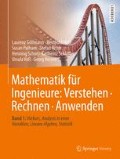Access this chapter
Tax calculation will be finalised at checkout
Purchases are for personal use only
Author information
Authors and Affiliations
Corresponding author
Aufgaben
Aufgaben
8.1
Nähern Sie die folgenden Ausdrücke durch das Taylor-Polynom \(T_{f,n,x_{0}}\in\mathbb{R}[x]\) der Ordnung n für den jeweils angegebenen Entwicklungspunkt x 0:
-
a)
\(f(x)=\sin^{2}x=(\sin x)^{2}\) für \(x_{0}=0\) und n = 6
-
b)
\(f(x)=3x^{4}+5x^{3}+x^{2}-4x+9\) für \(x_{0}=1\) und n = 5
-
c)
\(f(x)=\displaystyle\frac{\exp(2x+1)}{2x+1}\) für \(x_{0}=0\) und n = 2
-
d)
\(f(x)=\tan x\) für \(x_{0}=0\) und n = 4
-
e)
\(f(x)={\mathrm{e}}^{x}\) für \(x_{0}=0\) und n = 3
-
f)
\(f(x)={\mathrm{e}}^{x}\) für \(x_{0}=1\) und n = 3
8.2
Es sei \(f:\mathbb{R}\rightarrow\mathbb{R}\) eine beliebig oft differenzierbare Funktion mit \(f^{\prime}(x)=f(-x)\) für alle \(x\in\mathbb{R}\) und \(f(0)=1\).
-
a)
Berechnen Sie das Taylor-Polynom von f der Ordnung 4 um \(x_{0}=0\).
-
b)
Es kann sehr leicht gezeigt werden, dass die Taylor-Reihe von f um \(x_{0}=0\) für alle \(x\in\mathbb{R}\) absolut konvergiert. Wie lautet deren Grenzwert? Hinweis: Aufgrund der absoluten Konvergenz dürfen die Summanden umgeordnet werden.
8.3
Es sei \(I\subset\mathbb{R}\) ein Intervall und \(f:I\rightarrow\mathbb{R}\) eine differenzierbare Funktion mit \(f^{\prime}(x)> 0\) (bzw. \(f^{\prime}(x)<0\)) für alle \(x\in I\). Zeigen sie, dass f streng monoton wachsend (bzw. streng monoton fallend) ist. Hinweis: Zeigen Sie dies durch Widerspruch unter Verwendung des Mittelwertsatzes der Differenzialrechnung.
8.4
Bestimmen Sie die Fourier-Reihe der Sägezahnschwingung
für \(k\in\mathbb{Z}\).
8.5
Bestimmen Sie die Fourier-Reihe für die \(2\pi\)-periodischen Funktionen
und
Was fällt auf (Additionstheoreme)?
Rights and permissions
Copyright information
© 2017 Springer-Verlag GmbH Deutschland
About this chapter
Cite this chapter
Göllmann, L. et al. (2017). Reihenentwicklungen. In: Mathematik für Ingenieure: Verstehen – Rechnen – Anwenden. Springer Vieweg, Berlin, Heidelberg. https://doi.org/10.1007/978-3-662-53867-8_8
Download citation
DOI: https://doi.org/10.1007/978-3-662-53867-8_8
Published:
Publisher Name: Springer Vieweg, Berlin, Heidelberg
Print ISBN: 978-3-662-53866-1
Online ISBN: 978-3-662-53867-8
eBook Packages: Life Science and Basic Disciplines (German Language)

